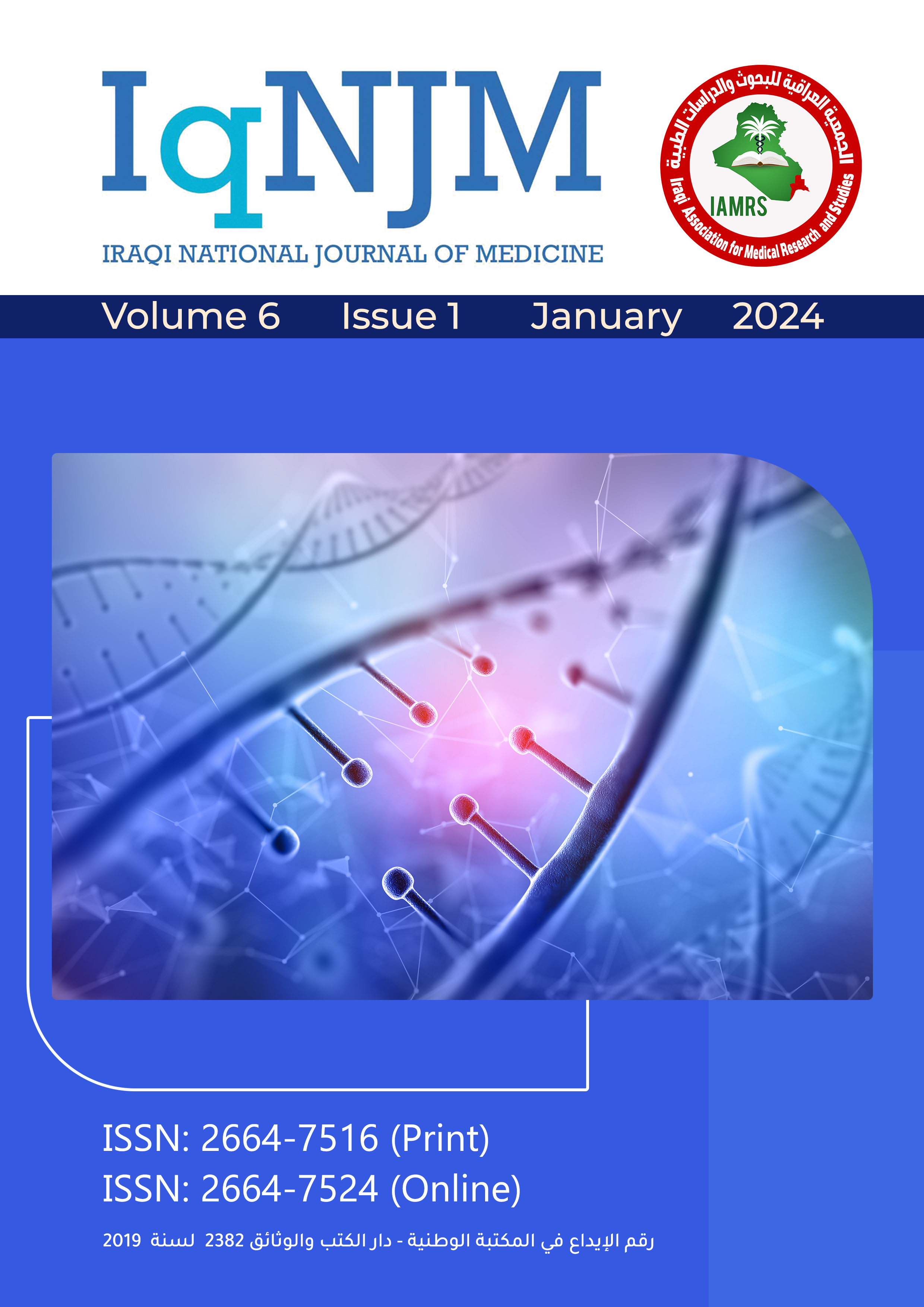Bacteriological profile in blood culture proven neonatal sepsis
Main Article Content
Keywords
Neonatal sepsis, Blood culture, Early-onset sepsis, Late-onset sepsis
Abstract
Background: Neonatal sepsis is a systemic infection caused by bacteria, viruses, fungi, and parasites. It results in significant morbidity and mortality, accounting for up to half of all newborn deaths in developing countries. Aim: Hence, this study aimed to determine the bacteriological profile of neonatal sepsis and assess its relationships with other demographic variables. Methods: A prospective, cross-sectional study was carried out on 87 neonates with blood culture-proven neonatal sepsis. They were categorized according to the age of onset of symptoms as having early-onset sepsis and late-onset sepsis. The bacterial profile that resulted from their blood cultures was analyzed. Results: The findings revealed that the most common isolated bacterial was Staphylococcus aureus, reported in 34.48% of the patients. Collectively, Gram-positive bacteria represent 67.82% of bacterial profiles versus 32.18% for Gram-negative bacteria. Significantly more Acinetobacter spp. were isolated from newborns with EOS than those with LOS (23.08% vs 6.56%). Contrarily, Streptococcus viridans were significantly more common among neonates with late-onset sepsis than those with early-onset sepsis. Interestingly, Gram-negative bacteria were present more frequently (53.85% vs. 22.95%) in infants with EOS than LOS, indicating a significant difference. In addition, Gram-positive bacteria accounted for 77.59% of sepsis in full-term neonates and 48.28%% of preterm neonates, with a significant difference. Conclusions: Early-onset sepsis and premature newborns were more likely to have gram-negative bacterial sepsis, whereas late-onset sepsis and full-term neonates were more expected to have gram-positive bacteria.
References
2. Shane AL, Sánchez PJ, Stoll BJ. Neonatal sepsis. Lancet 2017; 390:1770-80. https://doi.org/10.1016/S0140-6736(17)31002-4.
3. Hammoud MS, Al-Taiar A, Al-Abdi SY, Bozaid H, Khan A, Almuhairi LM, et al. Late-onset neonatal sepsis in Arab states in the Gulf region: two-year prospective study. International Journal of Infectious Diseases 2017;55:125-130. doi: 10.1016/j.ijid.2017.01.006
4. Abdul-Rahman SM, Khider AK. Neonatal sepsis: Bacteriological profile, molecular detection and antimicrobial susceptibility test among pre-term pediatrics in Erbil city, Iraq. Zanco J. Med. Sci. 2020;24(2):256-273. doi:10.15218/zjms.2020.030
5. Huynh BT, Padget M, Garin B, Delarocque-Astagnea E, Guillemot D. Bacterial neonatal sepsis and antibiotic resistance in low-income countries. Lancet 2016387(10018):533e534.doi: . 10.1016/S0140-6736(16)00220-8
6. Hammad E and Zainab M. Meta-analysis on factors influencing early-onset neonatal sepsis. Journal of Applied Sciences and Research 2018 Nov;1(8):20-2.
7. Sorsa A. Epidemiology of neonatal sepsis and associated factors implicated: Observational study at Neonatal Intensive Care Unit of Arsi University Teaching and Referral Hospital, South East Ethiopia. Ethiop J Health Sci. 2019;29(3):333-342.doi: 10.4314/ejhs.v29i3.2
8. Haslam DB. Epidemiology of Infections. In: Kliegman RM, Geme JW, Blum NJ, Shah SS, Tasker RC, Wilson KM (eds), Nelson Textbook of Paediatrics, 21st ed Vol 1. Philadelphia: Elsevier, 2020:996-1004.
9. Almohammady MN, Eltahlawy EM, Reda NM. Pattern of bacterial profile and antibiotic susceptibility among neonatal sepsis cases at Cairo University Children Hospital. Journal of Taibah University Medical Sciences 2020;15(1):39-47. doi:10.1016/j.jtumed.2019.12.005
10. Jatsho J, Nishizawa Y, Pelzom D, Sharma R. Clinical and Bacteriological profile of neonatal sepsis: a prospective hospital-based study. International Journal of Pediatrics 2020; 1835945:1-9. doi:10.1155/2020/1835945
11. Mohakud MK, Mishra JP, Nayak MK, Mishra J, Pradhan L, Panda SS, et al. Bacteriological Profile and Outcome of Culture-Positive Neonatal Sepsis in a Special Newborn Care Unit Setting, Odisha. Cureus 2022; 14(5): e25539.doi:10.7759/cureus.25539
12. Dong Y, Speer CP. The role of Staphylococcus epidermidis in neonatal sepsis: guarding angel or pathogenic devil? International Journal of Medical Microbiology 2014;304(5-6):513–20. doi: 10.1016/j.ijmm.2014.04.013
13. Adane T, Worku M, Tigabu A, Aynalem M. Hematological Abnormalities in Culture Positive Neonatal Sepsis. Pediatric Health, Medicine and Therapeutics 2022;13:217-225. doi:10.2147/PHMT.S361188
14. Uwe NO, Ezenwa BN, Fajolu IB, Oshun P, Chukwuma ST, Ezeaka VC. Antimicrobial susceptibility and neonatal sepsis in a tertiary care facility in Nigeria: a changing trend? JAC Antimicrob Resist 2022 4(5):1-7. doi:10.1093/jacamr/dlac100
15. Boulos A, Rand K, Johnson JA, Gautier J, Koster M. Neonatal Sepsis in Haiti. Journal of Tropical Pediatrics 2017;63:70–73.doi: 10.1093/tropej/fmw077
16. Masaba BB, Mmusi-Phetoe RM. Neonatal survival in sub-Sahara: a review of Kenya and South Africa. Journal of Multidisciplinary Healthcare 2020 Jul;13:709-16. doi: 10.2147/JMDH.S260058
17. Ehsan S, Marium R. Bacteriological profile and antibiotic susceptibility pattern of isolates in neonatal sepsis. Pakistan Journal of Health Sciences 2023;4(3):44-49.doi: https://doi.org/10.54393/pjhs.v4i03.608
18. Acheampong EN, Tsiase JA, Afriyie DK, Amponsah SK. Neonatal sepsis in a resource-limited setting: causative microorganisms and antimicrobial susceptibility profile. Interdisciplinary Perspectives on Infectious Diseases 2022; 1-7. doi:10.1155/2022/7905727
19. Lim WH, Lien R, Huang Y, Chiang M, Fu R, Chu S, et al. Prevalence and pathogen distribution of neonatal sepsis among very-low-birth-weight infants. Pediatrics and Neonatology 2012;53:228-234. doi:10.1016/j.pedneo.2012.06.003
20. Das T, Saha J, Pal K, Barik KL. Bacterial etiology of neonatal sepsis, antibiotic susceptibility profile, and associated factors at Burdwan Medical College, Burdwan, West Bengal, India. J Child Sci 2021;11(1):e148-e154. doi: 10.1055/s-0041-1731305
21. Karmila A, Barchia I, Ramandati A, Zhang L. Clinical and bacteriological profile of culture-negative and culture-proven neonatal sepsis in Palembang, Indonesia. J Infect Dev Ctries 2022; 16(12):1887-1896. doi:10.3855/jidc.14638
22. Yusef D, Shalakhti T, Awad S, Algharaibeh H, Khasawneh W. Clinical characteristics and epidemiology of sepsis in the neonatal intensive care unit in the era of multi-drug resistant organisms: A retrospective review. Pediatrics and Neonatology 2018;59:35-41. doi:10.1016/j.pedneo.2017.06.001
23. Siddiqui T, Dubey A, Kar M, Patel S, Sahu C, Ghoshal U. Bacteriological profiles and antibiotic susceptibility of neonatal sepsis in a university hospital of Northern India. Journal of Family Medicine and Primary Care 2023;12(3):493-498. doi: 10.4103/jfmpc.jfmpc_1535_22
24. Hamiel U, Bahat H, Kozer E, Hamiel Y, Ziv-Baran T, Goldman M. Diagnostic markers of acute infections in infants aged 1 week to 3 months: a retrospective cohort study. BMJ Open 2018. Jan;8(1):e018092. doi:10.1136/bmjopen-2017-018092.
25. Ba-alwi NA, Aremu JO, Ntim M, Takam R, Msuya MA, Nassor H, et al. Bacteriological profile and predictors of death among neonates with blood culture-proven sepsis in a national hospital in Tanzania—a retrospective cohort study. Frontiers in Pediatrics 2022;10(797208):1-12. doi:10.3389/fped.2022.797208


